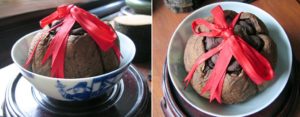Puer: Compressed, microbial, semi-infinite in variety

Puer teas are “different.” Most tea drinkers will never sample one in their lifetime or even know about them. Most puer lovers will never exhaust the choices if they live to be a hundred – including trying ones even older than that.
They are by far the most complex of teas, in terms of variety, processing, taste characteristics, marketing, counterfeiting, pricing, brewing, and history. You could go through this broad list and identify a puer uniqueness in comparison to any other tea type. There’s one more to add in the form of a question: are puers different in their known impacts on health?
Yes, decidedly so, according to the consensual findings of scientific papers published in respected journals.
A 2012 study found 60 bioactive compounds and six bacteria strains in its sample of pu-erhs. The authors concluded that there is an accumulation of evidence for their contribution to cardio health, but no smoking gun. That accumulation of findings in lab studies of rats and mice has included improvements in blood pressure, triglycerides, cholesterol, obesity, diabetes and other “Bad For You” elements of serum lipid profiles. Such animal studies don’t necessarily transfer to human subjects where so many other factors come into play: bioavailability, toxicity, dosage, biogenetics, medications and side effects. There have been surprisingly few studies outside the lab and using human subjects.
But the lab research shows very clearly the active power and effectiveness of puer’s microbial and bacterial agents. It’s not at all clear from the research how they work but why they work is very apparent: the highly “different” nature of the making of the tea.
The basics of puer processing: A minimalist summary
The processing of puer fully oxidizes the original leaf – the equivalent of cutting an apple open so that it browns. In tea, oxidation breaks down cell walls and stimulates a wide range of enzymatic interactions between the leaf’s over 600 compounds and the air. The oxidation can be stopped by heating, affecting the retention of multiple polyphenols – flavonols, flavonoids, and catechins. These affect taste, aroma, color, and potential microbiological impacts on the body, and hence health. Basically, green tea is minimally oxidized, oolongs 20-80%, and black teas fully so, with exceptions and variations in methods.
Puers are unique in that their bacteria continue to ferment over many years – 15 is still “young” – and there are ones that are over a century old, with claims of rare ones being made from leaf gathered from thousand-year-old bushes. They are wide-ranging in rich flavors, with descriptors like earthy, damp, and mushroomy. (The ones that are poorly made and matured have the scent of compost but a fine puer reminds you of the forest floor during an autumn walk in the woods.)
Pile-fermentation: The Catalyst that Creates Shou Pu-erh
Compressed teas come in many forms: brick, bowl, bing, tuocha (birds nest), or pressed inside an orange or bamboo stem. They may be “raw” or“cooked.” These evolved historically on the basis of trade: storage, transportation, and portage along the thousands of miles of the Tea Horse Road from the South West province of Yunnan, still the fabled home of puers, to Tibet, Nepal. Mongolia and even the Balkans, where they were used as a barter currency as late as the 1920s.
Puers are made from the same Camellia Sinensis bush as any other true tea: Japanese tiny sencha green leaf, wiry and curly Chinese and Taiwan oolongs, or Darjeeling long, thin tips. However, the best come from large broadleaf wild trees that have not been kept trimmed down and laid out in rows. The processing is equally distinct from the mainstream of tea. The base tea is fully oxidized but does not kill off all the enzymes in the leaf. These continue to “ferment” over many years, creating the palette of flavors puer is famed for. Basically, green and black teas are bacterially and microbially dead while puer continues to live.

Read next
Tea Discovery: Crab Pincer Tea



There is lots of info here it is overwhelming, I just want some good recommendations on the best teas for a healthy heart & anti-cancer herbal choices.
EDITOR’S NOTE: Drink three to five cups a day of green tea. The right choice is the tea that you find pleasing. It does not matter if the tea is made in Japan or China, India or Thailand, or Korea. The camellia sinensis cultivars grown the tea lands are similar. Among herbals, hibiscus and Hawthorne show promise in providing cardiovascular support, but no plant on earth has been the subject of more study than tea. It’s quite amazing how many good things plants can do. https://teajourney.pub/tea-and-heart-health-benefits-of-long-term-consumption/